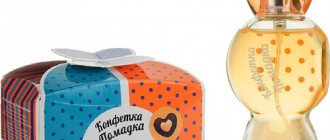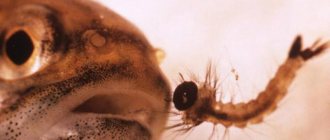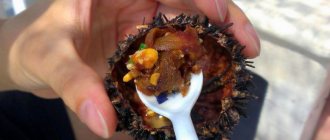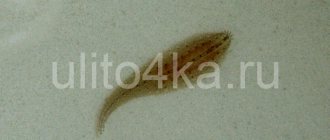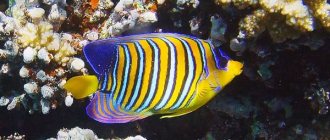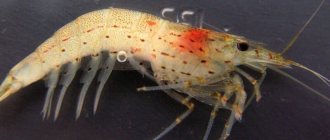Representatives of the carp family (lat. Cyprinidae) are characterized by variability in exterior and size. One of the cutest species is the blue bream - a medium-sized fish from the genus of the same name, similar to a bream. The low population and special environmental requirements make catching this fish an exciting activity for both amateurs and professional athletes. In order for fishing to be successful and have a chance to catch a trophy bluegill, it is important to know the characteristics of its habits, appearance, diet, habitat and reproduction.
Description of the species
Despite the common features with bream fish, the bluegill (lat. Ballerus ballerus) is not their closest relative, but forms its own family branch, which, in addition to it, includes the white-eye (lat. Ballerus sapa).
The species received a catchy and easy-to-remember name for the color of its back in dark blue tones with a green tint, which, in combination with a light belly, corresponds to a protective (concealing) color according to the principle of countershadow.
The protective mechanism is adjusted to diffuse overhead lighting, which is typical for all bodies of water. Due to the fact that the shadow falls on the light areas of the body, the fish visually acquires a monotonous color and merges with the surrounding background.
Other features of the blue chinese's appearance include:
- elongated high body (maximum width 1/3 of length);
- flattened sides of a silvery-white color;
- small scales of cycloid shape (with a rounded posterior edge);
- pointed head with terminal mouth turned upward;
- arched lateral line.
The appearance characteristic of the species is also formed by unusual yellowish-gray fins: high and short dorsal, very long (35-45 rays) anal, with a notch and built-up caudal lobes.
Maximum size of blue
The fish does not amaze with its size - the catches contain specimens 200-400 g long and 20-30 cm long. In large rivers and reservoirs with a rich food supply, individuals 40-45 cm tall and weighing over one kilogram are found. The largest bluebird weighed about 2 kg, which is mentioned in some authoritative sources, for example in the “Encyclopedic Dictionary of Brockhaus and Efron”.
To learn more:
Description and characteristics of Baikal grayling
Differences between bluegill and white-eye and other fish
Many common nicknames (sintepa, sinchik, singa, sintyavka) clearly indicate the main external feature that allows one to accurately identify this species of cyprinids - the sapphire-olive color of the back. Difficulties may arise only for inexperienced fishermen who will need to distinguish bluegill from other fish of similar body shape and size: bream or white-eye.
Here you don’t need to look for subtle differences in fins, scales, color, but just pay attention to the structure of the mouth: it just looks down - it’s a white-eye (popularly called a glander, eye-catcher, klepets), and if the lips additionally form a retractable tube, it’s a juvenile bream ( white bream).
Podleschik
Appearance and gender differences
The body of Cichlazoma is elongated in length, flattened on the sides, and the back is high. The steep forehead of adult males has a fat pad. These cichlids have large eyes and a terminal mouth with thick lips. Fish can change body color when they are very irritated. In males, the head and back are dark gray in color, and the abdomen is olive green. Cichlazoma has large, shiny, greenish-blue scales. On the sides of young fish there are 8 transverse dark stripes, which then disappear, while the entire body becomes green with a bluish tint. The gill covers of blue-eyed cichlazoma are green and shiny. The anal and dorsal fins are long, pointed at the tips, have a greenish-blue color with a smoky tint and a narrow dark gray border along the edge. The shape of the caudal fin is round, greenish in color, with a gray edging. The pelvic fins are elongated, greenish in color, and the pectoral fins are smoky. The female cichlazoma is much smaller than the male, with less bright coloring. During spawning, its existing transverse stripes acquire a black color and a clear expression. The female's fins are shorter than those of the male's and are rounded at the ends. In this case, the female is decorated in the form of a large round black spot in the very middle of the dorsal fin, bordered by a wide shiny stripe of bright blue color. The length of the blue cichlazoma reaches 10 cm.
Habits and habitats
The species is characterized by a peaceful nature and leads a gregarious lifestyle in the bottom layers at a depth of 1.5-2 meters.
Despite its status as a lake and river fish, the blue tit is demanding on water quality, oxygen levels and suspended matter. He ignores turbulent rapids and drainless, swampy, heavily silted reservoirs.
In the summer heat, bluegill go to the depths, where they feed in small groups at the very bottom. It comes out into shallow water and into the upper layers of the reservoir only in the morning and evening. With the beginning of the cold season, the fish gather in large schools and move to riverbed holes, where they wait out bad weather and severe frosts.
The optimal habitat for blue bream is calm, wide reaches in large rivers, waste lakes and reservoirs. Fish can be found not only in the basin of the Baltic, Black, Caspian, and Azov seas, but also directly in slightly salty waters near the coast.
Where is bluegill found?
The territorial distribution of the species is fragmented and is inferior in area to bream fish. Sintz can be caught throughout the European part of Russia - from the Neva and Volga to the Ural River. At the same time, it is small or not found at all in the Moscow River, Lake Onega and Svir, inhabits only the lower reaches of the Kama, and has selectively taken root in some lakes of South Karelia and in the south of Ladoga. The bluebird especially likes deep reservoirs (Rybinskoye, Ivankovskoye, Uglichskoye), where clean running water is combined with a rich food supply and a fairly hard bottom.
To learn more:
Podust: fish lifestyle and fishing methods
The Volga, Don, Kuban, Narva and other rivers are inhabited by an anadromous form of blue bream, which spends a lot of time on the sea shelf fattening up. This is all the more important because the fish remains active all year round, and therefore requires significant energy reserves for wintering. After the ice breaks up, flocks of blue salmon move to the banks of rivers, lakes and reservoirs that are flooded during high water for intensive feeding and spawning, if by this time the reservoir has not managed to return to its usual boundaries.
Feeding and reproduction of mature blue bream
All small cyprinids are characterized by peaceful coexistence with other fish species. That is why their diet consists of plankton, benthos, ciliated and polychaete worms, small crustaceans and mollusks, and various insect larvae that live both in bottom sediments and in the intermediate layers.
In unfavorable years, the basis of the diet of the blue bream is algae, submerged plants, caviar and hatched fry of other fish. In turn, the blue tit population suffers greatly from constant persecution by perch, pike perch, pike, and burbot.
Spawning of blue salmon begins at a water temperature of +8-9°C and gradually increases its intensity as it warms up to +17-18°C. Depending on the geographic location of the region, this could be any month from April to June. The spawning ground is shallow water (0.5-1.0 m) with an abundance of vegetation, last year’s leaves, snags, and stones. Such a substrate serves as a reliable and well-camouflaging basis for 25-100 thousand sticky light orange eggs with a diameter of 0.8-1.5 mm, which are laid by the female in one go.
The time of puberty of the blue bream depends on climatic conditions, the quality of the food supply, the total population size and usually occurs in the 3-5th year of life with a length of 18-25 cm. The size of the individual directly affects the amount of eggs laid. In this regard, adult fish aged 7-8 years are several times more productive than sexually mature young fish.
To learn more:
The royal fish of the sturgeon family - sterlet
The incubation period for the development of eggs is 1-2 weeks. The hatched larvae, 5-6 mm long, motionlessly attach to the vegetation at the upper edge of the water and continue their growth due to the energy reserves of the yolk sac and the filtration of plankton. After 7-10 days they turn into fry, which begin to feed on nutritious benthos and by the end of summer grow to 6-7 cm.
Breeding
Sexual maturity in Cichlazoma gray occurs at 8-12 months of age. Breeding is not difficult if you get the right pair of fish. If fights occur between a female and a male, then the female should be removed as quickly as possible, then another one should be added. This can continue until the fish approach each other. Before spawning, breeders must feed heavily on live food. The aquarium for spawning should be at least 50-80 liters in volume, the water level in it should not be less than 30-40 cm. For the soil, take coarse sand, previously well washed. Place a flower pot in the darkest corner of the aquarium, and in the opposite corner, next to the air diffuser and heater, plant a large bush of cryptocoryne or echinodorus. For propagation of Cichlasoma immaculatum, tap water that has settled for 2 weeks with the following parameters is suitable: water hardness - from 6 to 15o, pH 6.8-7.2; water temperature - 28o C. Lighting must be diffused. Spawning begins in the morning. The female climbs into the pot, turns over with her belly up and glues 3-5 eggs to the inner wall of the pot. From there it floats upside down and then flips back over. At this moment, the male also turns upside down and fertilizes the eggs. This is repeated several times. In total, spawning takes almost 3 hours. The female lays 150-200 eggs. After spawning is over, the parent fish begin to take care of the offspring. They take turns climbing into the pot to fan the eggs with their fins. After 6-8 hours, the fish remove the dead eggs with their mouths. Sometimes the male begins to drive hard and at the same time beat the female. To avoid the death of the female, remove her from the spawning aquarium. While caring for the offspring, the breeding fish should not be disturbed: the aquarium should not be illuminated too much, and the fish should not be knocked or frightened - they may eat their eggs. After 2 days, large larvae appear from the eggs; at first they hang, attached to the walls of the pot, and then fall into the sand, gather in a heap and begin to shake their tails. On the 6th day, the larvae become fry with a large head and a small tail. Parents dig 2-3 small holes in the sand and transfer the fry into them with their mouths, constantly alternating these holes. You should start feeding the fry when they begin to swim out of the holes, gather in a flock and swim with their parents. During the first 2-3 days, the blue cichlid is fed with “live dust”, then they begin to feed small daphnia and cyclops, and there should be food in the aquarium constantly. The parent fish are fed bloodworms. After 2 weeks they are transplanted from the fry. After 15-20 days, the breeding fish can spawn again. If suddenly the parents do not care for the caviar, but start eating it, then the pot with the caviar should be removed from the aquarium and placed in a glass jar with a capacity of 8-10 liters. Next to it you need to place an air sprayer, which will enrich the water with oxygen and also circulate water near the caviar. After the larvae hatch, they need to be shaken off the wall of the pot so that they fall to the bottom of the jar. Then the pot is removed, the dead eggs are removed and the jar is shaded. After 6 days, they begin to feed the fry, and after another week they are moved to a large aquarium.
Liked? Share with your friends!
Social buttons for Joomla
Fishing for bluegill
Feeding activity continues throughout the year, with the exception of 3-4 weeks of spawning. After spawning, in May and June, the peak of the blue trout bite begins, and it willingly takes plant and animal baits not only in the morning and evening, but throughout the day.
The main gear is a feeder or light picker, a float rod and a bottom, preferably with a rubber shock absorber, which allows you to fish both the bottom and middle layers of the reservoir.
The gear is equipped with small hooks with a short shank No. 13-17 according to the international classification or No. 3-4 according to the domestic one. Despite the light weight of the fish, the main line must withstand snags on aquatic vegetation. Monofilament 0.25-0.3 mm optimally meets these requirements. For leashes, a fishing line is selected that is an order of magnitude thinner - 0.12-0.17 mm.
For successful summer bluegill fishing, you can use the following baits and attachments:
- steamed oats, wheat and pearl barley;
- canned peas and corn (medium size);
- plain, flavored or sweetened dough;
- Mastyrka (a mixture of pea puree and semolina);
- bread crumb (black, white);
- earthworm and dungworm;
- maggot, caddis larva, bloodworm.
Also, do not forget about the bait - it must be crumbly and contain sufficient quantities of ingredients that cling to the hook.
In July and August, bluefish are less active due to intense heat and decreased oxygen levels in the water, so they try to stay close to the bottom and feed mainly at dusk. Autumn cooling gradually returns the fish's appetite. At the end of September, October and beginning of November it can be fished throughout the daylight hours.
To learn more:
Subtleties of eel fishing: places and gear
Winter fishing for bluegill
For winter fishing from ice, a float or nodding fishing rod equipped with a jig is used: silver or golden “ovsinka”, dark “uralochka”, bright “lesotka” (light green, yellow, orange).
The bait is bloodworms, worms, and colored maggots. Colored threads, cambrics and beads, which are complemented by the same bloodworms, have proven themselves well. The maximum activity of bluegill bites always occurs in the second half of the day. On most reservoirs this is a period of time from 14-00 to 17-00.
Due to the fact that fishing is most often carried out at depths of over 3-4 meters, it is advisable to select a fishing rod model with a large reel spool diameter, which will significantly facilitate the search for fish due to the gradual fishing of different layers of the reservoir.
Conditions of detention
Blue-eyed cichlasoma is a rather aggressive and territorial aquarium fish, so it is better to use a species-specific aquarium to keep it. Males often fight over females. The gray cichlazoma tries to stay in the middle and lower layer of water. For comfortable maintenance, it is necessary to prepare an aquarium with a volume of at least 150 liters, equipping it with various shelters, for example, driftwood, various figures of stones with horizontal and inclined surfaces, caves and vertical stones that will serve as boundaries of territories. You can plant a couple of bushes of cryptocoryne and echinodorus in pots. Water parameters for keeping blue cichlazoma should be the following: water hardness - up to 15°, pH 6.5-7.0; water temperature - 23-25°C. Filtration, aeration and water change up to 25% of the volume once a week are also necessary. Blue cichlazoma is an unpretentious fish, it practically does not get sick and, with proper care, can live quite a long time. Cichlasoma immaculatum feeds on live food: bloodworms, large daphnia and even small fish, as well as substitutes.
Taste qualities
The fish has quite valuable gastronomic properties, which explains its massive commercial catch at the beginning of the 20th century. Tender and moderately fatty meat (<5%) lends itself perfectly to frying, baking, and steaming. In terms of drying, drying, salting and pickling, the taste of bluefish is in no way inferior to bream and most representatives of cyprinids. In addition, meat contains a lot of protein with low calorie content (130 kcal per 100 g), which makes it possible to use it in the diet menu.

